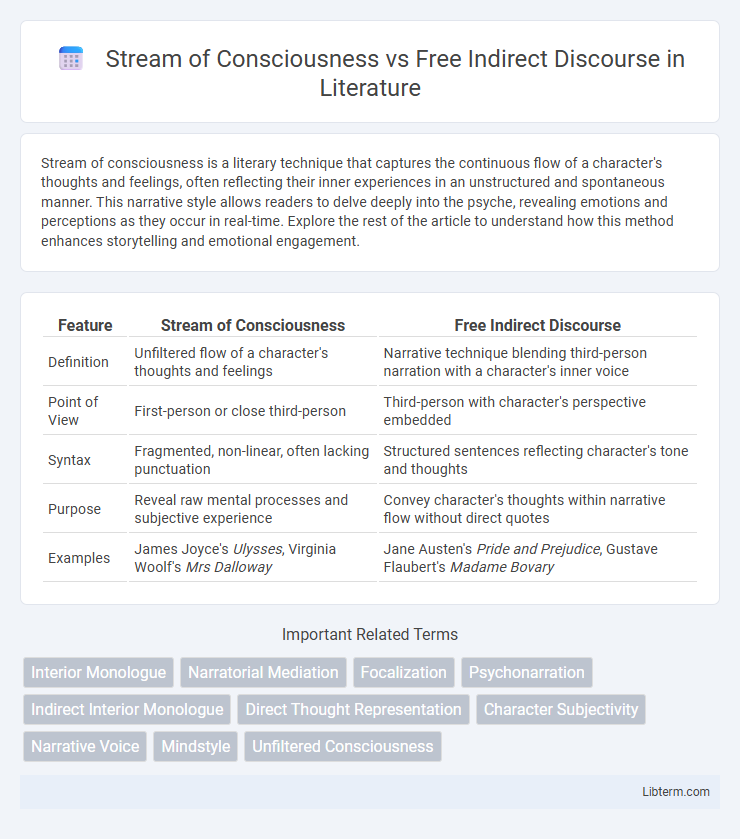Stream of consciousness is a literary technique that captures the continuous flow of a character's thoughts and feelings, often reflecting their inner experiences in an unstructured and spontaneous manner. This narrative style allows readers to delve deeply into the psyche, revealing emotions and perceptions as they occur in real-time. Explore the rest of the article to understand how this method enhances storytelling and emotional engagement.
Table of Comparison
| Feature | Stream of Consciousness | Free Indirect Discourse |
|---|---|---|
| Definition | Unfiltered flow of a character's thoughts and feelings | Narrative technique blending third-person narration with a character's inner voice |
| Point of View | First-person or close third-person | Third-person with character's perspective embedded |
| Syntax | Fragmented, non-linear, often lacking punctuation | Structured sentences reflecting character's tone and thoughts |
| Purpose | Reveal raw mental processes and subjective experience | Convey character's thoughts within narrative flow without direct quotes |
| Examples | James Joyce's Ulysses, Virginia Woolf's Mrs Dalloway | Jane Austen's Pride and Prejudice, Gustave Flaubert's Madame Bovary |
Understanding Stream of Consciousness
Stream of Consciousness is a narrative technique that seeks to represent the continuous flow of a character's thoughts, feelings, and sensory experiences in an unfiltered, often chaotic manner. This method captures the inner workings of the mind, blending memories, perceptions, and emotions without conventional syntax or clear logical progression. Key authors associated with Stream of Consciousness include James Joyce, Virginia Woolf, and William Faulkner, whose works demonstrate the technique's ability to immerse readers in subjective reality.
Defining Free Indirect Discourse
Free Indirect Discourse blurs the boundaries between a narrator's voice and a character's thoughts, presenting internal dialogue without explicit markers like quotation or italics. This narrative technique allows seamless integration of subjective experiences into the third-person perspective, preserving the character's tone and perspective. Unlike Stream of Consciousness, which captures raw, often disjointed thoughts in immediate flow, Free Indirect Discourse offers a more structured and grammatically conventional portrayal of consciousness.
Historical Origins and Literary Context
Stream of consciousness emerged in early 20th-century modernist literature, with pioneers like James Joyce and Virginia Woolf using this technique to depict characters' continuous flow of thoughts and sensory experiences. Free indirect discourse, rooted in 18th and 19th-century narrative traditions, gained prominence through authors like Jane Austen and Gustave Flaubert by blending third-person narration with a character's inner voice, creating a nuanced psychological perspective. Both techniques revolutionized narrative style by deepening the reader's access to characters' mental states within their respective historical and literary contexts.
Key Characteristics of Stream of Consciousness
Stream of Consciousness is characterized by a continuous flow of a character's thoughts and feelings, often presented in a disjointed or nonlinear manner to mimic natural thought processes. It employs internal monologue, fragmented syntax, and associative leaps to reveal the subjective experience of the mind without traditional narrative structure. Unlike Free Indirect Discourse, which blends third-person narration with a character's voice, Stream of Consciousness immerses readers directly inside the character's psyche.
Essential Features of Free Indirect Discourse
Free Indirect Discourse blends a character's thoughts and feelings with the narrator's voice, creating a seamless narrative perspective that reveals internal experiences without direct quotation. This technique maintains third-person narration while integrating subjective insights, often marked by shifts in tone, diction, or syntax reflecting the character's mindset. Unlike Stream of Consciousness, Free Indirect Discourse provides a more structured, less fragmented portrayal of consciousness, merging external narration with internal monologue.
Major Authors and Works Exemplifying Each Technique
Stream of consciousness is exemplified by James Joyce's "Ulysses," where the narrative delves deeply into characters' interior monologues, revealing unfiltered thoughts and sensory experiences. Virginia Woolf's "Mrs. Dalloway" also employs this technique, weaving multiple characters' inner lives seamlessly into the narrative flow. Free indirect discourse, used masterfully by Jane Austen in "Emma" and Gustave Flaubert in "Madame Bovary," blends third-person narration with a character's voice and perspective, allowing subtle shifts in tone and revealing thoughts without direct quotation.
Narrative Perspective: Internal vs. External Voices
Stream of consciousness presents an internal narrative perspective by directly accessing a character's continuous flow of thoughts and emotions, immersing readers in their subjective experience. Free indirect discourse blends internal thoughts with an external third-person narrative voice, creating a subtle shift between the character's mindset and the narrator's perspective. This technique allows the narrative to convey internal emotions while maintaining the appearance of an external, omniscient viewpoint.
Effects on Reader Engagement and Interpretation
Stream of consciousness immerses readers directly into a character's unfiltered thoughts, enhancing emotional intensity and creating a deep sense of psychological realism. Free indirect discourse blends narrator's voice with character's inner perspective, allowing nuanced interpretation and subtle shifts in viewpoint that engage readers through interpretative complexity. Both techniques foster intimacy and connection but differ in how transparently thoughts are presented, influencing reader engagement and interpretative freedom.
Common Misconceptions and Overlaps
Stream of consciousness is often misunderstood as mere unfiltered thought, yet it intricately blends sensory details and fragmented emotions to mirror a character's psyche. Free indirect discourse, by contrast, subtly merges third-person narration with a character's inner voice, frequently causing readers to confuse the two due to their shared introspective qualities. Both narrative techniques overlap in their capacity to reveal internal experiences, but stream of consciousness is typically more immersive and chaotic, while free indirect discourse maintains a structured narrative perspective.
Choosing the Right Technique for Your Story
Stream of consciousness delves deeply into a character's unfiltered thoughts and emotions, providing an immersive and intimate narrative style ideal for exploring complex psychological states. Free indirect discourse balances third-person narration with the character's voice, offering a versatile way to convey inner thoughts without disrupting narrative flow, making it suitable for maintaining story momentum while revealing character perspective. Choosing the right technique depends on the desired level of intimacy and narrative control, with stream of consciousness emphasizing raw, uninterrupted mental experience and free indirect discourse enabling subtle insight within a structured narrative framework.
Stream of Consciousness Infographic

 libterm.com
libterm.com